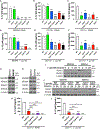The IRAK1/IRF5 axis initiates IL-12 response by dendritic cells and control of Toxoplasma gondii infection
- PMID: 38367238
- PMCID: PMC11559090
- DOI: 10.1016/j.celrep.2024.113795
The IRAK1/IRF5 axis initiates IL-12 response by dendritic cells and control of Toxoplasma gondii infection
Abstract
Activation of endosomal Toll-like receptor (TLR) 7, TLR9, and TLR11/12 is a key event in the resistance against the parasite Toxoplasma gondii. Endosomal TLR engagement leads to expression of interleukin (IL)-12 via the myddosome, a protein complex containing MyD88 and IL-1 receptor-associated kinase (IRAK) 4 in addition to IRAK1 or IRAK2. In murine macrophages, IRAK2 is essential for IL-12 production via endosomal TLRs but, surprisingly, Irak2-/- mice are only slightly susceptible to T. gondii infection, similar to Irak1-/- mice. Here, we report that upon T. gondii infection IL-12 production by different cell populations requires either IRAK1 or IRAK2, with conventional dendritic cells (DCs) requiring IRAK1 and monocyte-derived DCs (MO-DCs) requiring IRAK2. In both populations, we identify interferon regulatory factor 5 as the main transcription factor driving the myddosome-dependent IL-12 production during T. gondii infection. Consistent with a redundant role of DCs and MO-DCs, mutations that affect IL-12 production in both cell populations show high susceptibility to infection in vivo.
Keywords: CP: Immunology; CP: Microbiology; IL-12; IRAK; IRF5; Toll-like receptors; Toxoplasma gondii; cell signaling; dendritic cells; innate immunity; monocytes; myddosome.
Copyright © 2024 The Authors. Published by Elsevier Inc. All rights reserved.
Conflict of interest statement
Declaration of interests The authors declare no competing interests.
Figures







References
Publication types
MeSH terms
Substances
Grants and funding
LinkOut - more resources
Full Text Sources
Medical
Molecular Biology Databases
Miscellaneous

